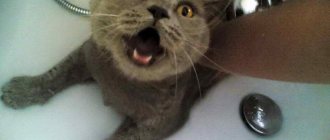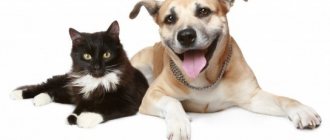How to stop a dog or puppy from chasing cats - 10 simple tips
It's hard to deny the fact that dogs and cats don't like each other. And if a cat, seeing a dog from afar, runs away, climbs a tree, or takes a tenth route around its “enemy,” the dog is unlikely to adequately react to a calmly sitting, much less a running away cat. The pursuit will begin. Therefore, let's look at how to wean a dog from chasing cats on the street.
This feature of your pet can lead to injury to an innocent animal. In addition, the dog can get hit by a car, scare passers-by, children, or get lost. And few people enjoy it if a calm, well-mannered pet on a walk, having noticed a cat, begins to hunt and run after the cats at full speed with a ringing bark.
What is the danger of the situation?
It is impossible for a pet to feel that such behavior is the norm.
When a dog attacks, the cat often runs away. Both animals in pursuit do not sense secondary dangers, so they often get hit by cars. It is important not to praise the dog for aggression towards the cat after the incident. Even slight approval and ignoring the situation instills in the animal the habit of attacking small animals.
Uncontrolled aggression on the part of a dog is fraught with serious injuries and even death for a cat. On the other hand, if a puppy attacks, then he has every chance of receiving precise blows with his claws in the eyes and nose with the ensuing consequences.
Why do dogs chase cats?
To stop your dog from chasing cats on the street, be patient. This habit is inherent in nature, especially among representatives of hunting breeds. Dogs, experiencing the hunting instinct, simply cannot resist it.
Unfortunately, it will take more time to wean an adult dog from this harmful habit, so it is worth properly socializing your pet and instilling useful behavioral skills in it at an early age.
Important! A dog, regardless of age and breed, must unquestioningly follow commands, which is achieved through systematic exercise and training.
At home and on the street, the dog must behave well, react adequately to relatives and other animals, so as not to cause problems for the owner and people around him. When chasing a cat, it is almost impossible to control the dog. Carried away and succumbing to the hunting instinct, the dog rushes headlong after his “prey.” For him, nothing and no one around exists. Just a cat running away.
- In this way, dogs assert themselves and increase their self-esteem. By chasing the “victim”, the dog shows dominance, shows its strength and advantage.
- Representatives of hunting breeds chase cats for fun. For example, terriers, setters, spaniels, sighthounds, hounds, and greyhounds react sharply not only to cats, but also to any moving objects.
- Dogs' dislike of cats can also be caused by a puppy or adult dog being scratched by a cat or a cat guarding its offspring or territory. Dogs remember their offenders for a long time, study their behavior, and at any opportunity, sooner or later they will take revenge. Only a completely innocent animal, or worse, a small defenseless kitten, can suffer.
At the same time, there is a category of dogs that absolutely do not react to cats. For example, if from an early age the pet has been in contact with a cat at home or the dog has a calm disposition, a phlegmatic character, or is properly socialized.
Why dogs don't like cats: legends, myths, fairy tales
0 Source:
In different cultures there are interesting legends and other monuments of oral folk art that explain why dogs do not like cats. The most popular of them came from China. This fairy tale is not without a rational grain and, if it does not explain the reasons for the hostility towards Murkas, then at least it makes you think.
0
Source:
One day, a dog saved a girl from death, who turned out to be the daughter of a ruler. To celebrate, the happy father issued a decree, according to which every resident had to feed the dogs in abundance and provide them with shelter. They decided to spread it simply: by tying a scroll to the savior’s tail, on which the will of the ruler was stated. To celebrate, the satisfied dogs decided to organize a holiday, prudently giving the treasured scroll to the cat for safekeeping. However, in the morning the document was not there, and the keeper said that mice had stolen it. The dogs did not believe the confession and attacked the cat. Since then, it has become a tradition that they do not like cats, and they, in turn, chase mice.
What to do if your puppy is chasing cats on the street
Proper adaptation and socialization will help wean you off this. From an early age, the dog must respond adequately to external stimuli, regardless of the strength of their manifestation. Teach your puppy to behave correctly at home and on walks, since it is much more difficult and longer to train an adult dog to have proper manners and obedience.
The first commands that a puppy should master after he begins to respond to his nickname and fully adapts and gets used to the members of his family are “Place”, “Fu”, “No”, “Come”. The dog must carry them out unquestioningly.
- The first walks should take place in a quiet place , away from general dog walking areas. Walk your dog only on a leash, analyze what attracts your dog’s attention most on the street and adjust its behavior in the right direction.
- Supervise your pet at all times if it is not on a leash. Let your dog go for a free run only when the dog follows the command “Come to me.” At the same time, constantly monitor what your pet is doing.
- Behave calmly and confidently while walking. Since street cats are part of the environment, meeting these animals is not an event of the century. If the dog feels your uncertainty and confusion, the educational process will not bring results.
In general, a dog’s reaction to a cat is quite predictable, so divert the pet’s attention from such an irritant and it is better to do this before the dog sees the cat and starts chasing the poor animal. If the puppy becomes interested in the cat or runs after it without responding to your commands , continue calling the dog until it responds to the call. You can try to switch the dog's attention to another stimulus. For example, clap your hands, whistle, or say the dog's name loudly.
Assess your dog's interest level
It is important to understand the reasons that prompt your pet to run after cats. Usually they rush off to play with the cat or their innate instinct is triggered.
In this case, it is necessary to intervene to prevent the animals from harming each other. Cats can be very aggressive when protecting their offspring.
When a dog chases a cat as if it were prey, the situation is very serious. The dog may kill him or suffer himself. During the chase, she does not notice what is happening around her. Your pet may get run over by a car or be chased by stray dogs, who will begin to act aggressively against your pet.
Observation
When taking your dog outside, constantly monitor its behavior, and always observe how it reacts to your commands. If a cat appears in your home, do not leave the animals unattended for a month. Encourage both for good behavior, and also strictly reprimand for conflicts that arise.
Nutrition
The dog should not be allowed to eat from the cat's dishes. This causes stress for the cat. He will “take revenge” on the offender, and also show aggression towards him. A very good situation is when the animals’ bowls are nearby, and they calmly react to each other’s proximity while eating.
However, this is not easy to achieve, as the dog will try to eat the cat's treat. Patience, as well as long-term training, will teach your pet not to look into “someone else’s” plate. Exercise your dog should be done regularly. It is important to let her understand how to behave in the presence of a cat. Repeat the exercises many times, encourage your pet and it will lead to results.
Currently reading:
- Review of the best dog breeds for apartments
- Games to choose for training a dog
- The American Cocker Spaniel is an adroit hunter and loyal friend.
- Recommendations for obedience of a dog if it growls
How to stop an adult dog from chasing cats
It is not as easy to train adult dogs to chase cats as it is to train puppies, so be patient. You can use the same methods as for puppies. If you adopted an adult dog from a shelter and it is not obedient and has good manners, contact a dog trainer for help. Follow all the specialist’s recommendations, consolidate the skills acquired on the training ground at home and on walks. Over time, thanks to systematic training, the dog will wean itself from harmful manners and bad habits.
- Correct behavior with encouragement and reprimand. If the dog reacts sharply to cats or other animals, be strict and ensure that the commands “Come”, “Fu”, “No” are followed. Dogs should immediately come to you when called, despite the presence of external stimuli. If your long-distance pet shows no interest in cats, always praise, pet him and reward him with treats.
Important! Don't scold your pet for being incontinent. A prohibition only fuels interest, and if physical force is used in addition to reprimand, the dog may spite you.
- Learn how to behave properly with a dog. Try to completely refuse rewards and every time the dog shows disobedience or is about to start a hunt for a moving object, scold the dog in a stern tone and lightly slap him on the butt. You can also use sounds that are unpleasant to the dog's ears, for example, Fischer discs.
- If the dog is uncontrollable and cannot suppress its hunting instinct, keep the dog on a strict collar. One strong impact is better than constant tugging on the collar.
- You can use special devices, for example, ultrasound, electrical impulse. The last option is very effective and efficient, but quite painful for dogs.
Important! Electric collars should not be used to correct the behavior of animals suffering from cardiovascular pathologies, overly fearful or emotional individuals, as well as old, weakened dogs.
Before using special products and collars, consult a dog trainer.
Method two is to train the dog to stop unwanted actions.
If you intend to teach your dog to respond to cats, you will have to teach him to clearly respond to commands.
- Hold a piece of meat in each palm. Bring one hand to your pet's nose and let him smell. Your pet will understand well that there is a “yummy” sandwiched in the palm of your hand. The hand should be kept clamped, not allowing him to get to the treat;
- When trying to get the contents of your fist, pull the dog back and say “ugh”. She must clearly understand that you do not like her behavior. It is important to ignore her behavior and ensure that she stops all attempts to get to the tasty morsel;
- When the pet obeys the “fu” command, praise it and give it a treat from the other hand. Giving treats from a clenched fist that the dog wanted to unclench is not allowed.
- The exercise must be constantly repeated in order to bring the execution of the owner’s commands to automaticity. The dog must, on command, stop trying to get a treat from a clenched fist and sit in front of the owner.
Once the command has been sufficiently practiced, start using it in the presence of the cat. As soon as the animals are nearby, say “fu”. The dog will remember the command and associate it with a treat clenched in his fist. It is important to ensure that he leaves the cat alone at the command “fu” and does not perceive the “tabby” as prey.
How to train a dog to get along with a cat at home
An equally serious problem is when a dog, living in the same area as a cat, in a house or apartment, does not allow the animal to exist in peace. If a dog reacts inappropriately to a cat, the animal’s nervous system suffers. Fluffy is forced to constantly sit on elevated surfaces and move around the house furtively.
It is best if the animals were taken at the same time, and they get used to each other from a young age. But if you get a cat after a dog, under no circumstances allow conflicts between animals or the development of hatred. If a cat is chasing a puppy or dog, spray it with a water pistol or spray bottle. Cats are afraid of water.
Scare the fluffy with a sharp sound. Do not allow the cat to eat or drink from the dog's bowls, or sleep in the house or on the dog bed. The brazen behavior of a cat will sooner or later provoke a conflict.
If a dog appeared in the house first, and then a kitten, accustom the animals to each other gradually.
- At first, do not leave them uncontrolled.
- Separate animals into different rooms.
- Stop any aggression and do not allow the dog to display its hunting instinct. Punish your dog for disobedience and inappropriate reaction to the cat at home and on the street.
- Do not allow your dog to lunge at your kitten or cat if the animal approaches the bowl.
- Make sure that the dog does not disturb the cat when he is on the tray.
If you don’t trust your dog, when leaving home, do not leave the animals in the same area or arrange a place on a hill for the cat so that the fluffy one feels relatively safe. Treat and give equal attention to all pets in the house so that no one feels hurt or left out.
Many factors play a role in the relationship between dogs and cats and other animals. Therefore, if you were unable to cope with this problem and the dog continues to chase cats on the street or at home, contact a dog handler for help.
Foraging
Competition for food and edible waste was most often one-sided. Dogs occupied a more advantageous position when they were close to people. Cats had to rely on their natural agility to avoid various troubles.
Guardian correspondent John Bradshaw once studied the behavior of wild cats in a Turkish village. One year, cats were everywhere and obtained food by begging for it from local residents and tourists. The following year, packs of dogs were already roaming the streets, and the journalist got the impression that the cats had disappeared. He thought so until he looked at the village from above and saw that the cats had simply moved onto the flat roofs. Most likely, they went down in search of food at night when the dogs were sleeping.
Puppy chasing a cat
Hello again! Thanks to your advice, we solved the problem with socializing the puppy, but now we can’t figure out another one for about a month and a half.
Since the situation is usually exactly the opposite, I will try to describe ours in more detail.
As I already said, we have a Russian spaniel puppy, female, 4.5 months old. The problem is that the domestic cat is almost constantly chasing. We tried giving the dog a light slap on the butt - it didn’t help. Locking yourself in another room is the same. She doesn’t really care about street cats (she can be eager to chase them, but she reacts to “ugh” or “to me”), sometimes she can snort, but no more. At home, as soon as the pet is in her field of vision, she rushes like crazy. One day, when the dog was really annoyed with the cat, the second one began to hide from it on the windowsill, under a table, chair, etc., but in this case the dog itself began to look for it. Previously, the dog behaved more or less calmly when the cat came to my feet, in this case she simply sniffed it and continued to do her business, but if the cat suddenly “said her fi” (she is extremely untamed), the dog is there began to pursue her. Now, as soon as the cat comes to me, the whole apartment barks, and the dog does not calm down until the cat leaves me. Do I understand correctly that this is jealousy?
We also have a very difficult situation with the dog’s water bowl - sometimes he allows the cat to drink from it, sometimes not. No matter what the dog’s mood, we immediately sit the cat near its bowl, but in this case it refuses to drink. What is the cat trying to show with this behavior?
Previously, when the dog saw a cat, I would hold it by the collar, say “ugh,” and as soon as the dog stopped squirming (there’s no other word for it), I praised it and gave it a treat. A couple of days ago I read an article that this method is incorrect, because... A dog that is forcibly restrained while a cat is in its field of vision perceives this as a provocation.
Our cat is a mongrel, she is 11 years old and weighs 3 kg, so she is not suitable as a playmate for a puppy. We picked her up from the street and she was apparently taken away from her mother early, because... She always showed play aggression, which is why none of the family members were particularly fond of playing with her. At the same time, the cat didn’t touch the dog even once, when it got really annoying - she hissed somehow, tried to hit her with her paw, but even with the strongest squeal, she never hurt the dog (but the owners, after they wanted to pet her , “knocked me in” just like that). When we brought the puppy, the cat showed a little interest in him, then simply did not pay attention to him, and then the puppy began to chase the cat.
Please tell me what is the best method to wean a dog? Is this aggression or normal flirting? The dog wags its tail when it sees a cat, but I read that this can also be aggression, especially since this breed has excellent hunting instincts.
Why can’t a cat teach a puppy a lesson and allows itself to be chased (not to the point of gouging out its eyes and scratching its nose, of course)? Owners - please, but with the puppy, they say, sort it out yourself. Could jade somehow influence her behavior? Before the dog, already sick, she behaved as usual: she loved to play, was active, scratched when something didn’t suit her. Now she also plays, but extremely rarely, if there is a dog somewhere nearby.
In general, when we adopted the puppy, we were very afraid that the cat would start to be jealous, refuse to eat, go to the toilet, we even wanted to trim her claws just in case. In fact, the cat eats regularly and also goes to the toilet, but lately she has begun to look around more often. The puppy is so smart - he follows commands and reacts to fuss, but if there is a domestic cat in sight, then it feels like the brain is completely switched off. We don’t leave them alone, we always keep an eye on them, especially when the cat goes to the toilet (she likes to go to the toilet first, then report her business, wait until they clean up, and go to the big one; in general, a whole ritual) .
I consulted with one specialist of this breed, who said that perhaps after changing teeth (about 6 months) the dog’s behavior will change dramatically and it will stop chasing the cat. This is quite a long time, we cannot wait, so please tell us how to solve this problem.
Historical reasons
A dispute between two dogs is often resolved without actual fighting because dogs have inherited a complex set of signals from the wolf, their ancestor. These signals stop the animal when it sees a more dangerous opponent. Cats, unlike dogs, originate from solitary predators. They lack such abilities because they do not have such a frequent need for contact. It follows that cats are more cautious, especially in deciding whether to get into a fight or not.
Dogs were domesticated by early hunter-gatherers approximately 15,000 years ago, if not earlier. One can only speculate whether they were then “man’s best friends” or not. By the time cats appeared, dogs had already played a significant role in human life: they hunted next to him, guarded houses, herded and drove livestock, and even kept him warm on cold nights.
Cats first showed an interest in human homes about 10,000 years ago . Although this can be called a kind of opportunism. In those days, the human habit of storing food led to the emergence of house mice as a serious pest. Only since the time of the ancient Egyptians has the first evidence of cohabitation between cats and humans been visible. Dogs have had the advantage for thousands of years of being well cared for by their owners, while very few cats have been able to do the same.
What to do if your dog is chasing cats
Hello, dear readers!
The dog is a rather affectionate and friendly animal that simply amazes with its devotion and dedication. It is impossible to understand just one thing: why does she hate cats so much? On the streets we often see dogs chasing cats, trying to harm the little fluffy ball. In this article we will look at the reasons for chasing and aggression , and we will talk about why pets fight among themselves.
Lack of fear in cats towards dogs
Cats are practically not afraid of dogs. This is one of the reasons why cats are more likely than dogs to initiate fights. Instead of running away from an approaching dog as quickly as possible, the cat remains alert and thinks about the current situation.
Cats tend to tease canine representatives. They often slowly walk past dogs, wagging their tail, provoking them into conflict. In a critical situation, the cat quickly climbs a tree or hill without any sense of fear or danger.
Dogs and cats - the same strength of character and different lifestyles
There are many opinions on the topic of dogs hating cats. And this is not surprising, because pets have completely different lifestyles and worldviews. A dog of any breed is a hunter by nature, the pack instinct prevails in it, and having received prey, the dog will certainly share it with its relatives. The cat is a quiet creature that prefers solitude. She will not share food, but will quietly eat it, hiding in a secluded corner. However, these warring animals have much in common. They are both predators, and a predator will defend its own territory to the last. Dogs, from time immemorial, have been accustomed to occupying a leading position, and therefore will not allow four-legged competitors to cross the boundaries of someone else's territory.
Most scientists argue that cats are not afraid of dogs specifically, they are frightened by completely unnecessary violation of personal space. In addition, the love of loneliness is often the cause of fears. The dog, on the contrary, craves play and communication. Many breeds run after cats simply out of curiosity, and when they catch up with the animal, they sniff and run away. For example, Labrador. Yes, but the outcome of such an acquaintance is not always predictable - due to its good nature, the dog can get a slap in the face from the cat. The same cannot be said about a shepherd or a bulldog. The dog’s reaction depends on the cat’s behavior: if she simply runs away, the dog will want to play catch, but when the first one begins to hiss and scratch, then such behavior will be followed by a corresponding response.
Boredom and desire to play
Once again, different language comes into play. If the puppy wants to show his affection, to play, he wags his tail, which the cat again sees as aggression.
The dog is ready for communication and pampering, she wants to play catch. But the cat doesn’t like this type of communication. She is not happy when boundaries are violated and personal contact is made. And if there were any other animal in the place of the dog, the purr would act the same way.
Let's imagine that a puppy came to meet a cat and it lowered its ears, arched its back, wagging its tail a little - all signs to attack the noisy and pestering creature. How does the dog understand this? Indeed, in his language it is precisely this behavior that is associated with the latter’s subordination. The puppy naively believes that the cat is afraid and a “joyful meeting” occurs after which the dog will remember for the rest of his life that it is better not to meet with cats and there is no need to expect anything good from it.
Differences in Signal Understanding
A well-trained dog perfectly understands the owner’s commands , but not always the cat’s movements and habits. Identical movements of the tail or paws of dogs and cats are interpreted differently:
- Swinging the tail from side to side. For a dog, such a gesture is playful and friendly; cats regard it as aggression or a warning of danger.
- Pulling into an arched position. Thus, the cat begins to prepare for an attack, but the dog does not understand this. As a result, he gets a paw on the nose or fully feels the force of the cat's claws.
- A raised paw for a cat is an alarming signal indicating a possible attack. For a dog, this is simply a friendly gesture that provides for further pleasant relationships.
- Purr. This is how a cat expresses pleasure and joy, while a dog, on the contrary, prepares to attack.
How to stop a dog from chasing cats
To do this, it is necessary to properly raise the puppy from the first months of life. Constant and effective training, as well as mutual understanding between the pet and the owner will help achieve the desired effect.
Work through a training program with your pet in the presence of cats. Over time, your dog will no longer perceive the cat as an enemy. Do not provoke your four-legged friend on the street - while on a leash, he will certainly start running after the lump running past. If the dog is on a leash and cats are walking nearby, this is also dangerous. Surely she will want to hunt and the dog will catch the cat in any case.
Humanity has farted 17 quadrillion times throughout history.
The average person farts 14 times a day. The Deadspin publication was not too lazy to count how many times the entire population of the planet farted in this case. We know approximately how long we have inhabited the Earth, we know how many years we live on average, and we know how many of us there are. This allows us to make a rough calculation. That comes out to an astonishing figure of 17 quadrillion farts.
ILLUSTRATION: PIRO4D / PIXABAY / FAKTRUM
What to do if there is a cat and a dog living in the house?
If two warring parties live in the same house, then the hardest thing will be for their owner. He will need to make a lot of effort to make them friends. We will give some useful recommendations that will help you achieve extremely positive results:
- The main rule is to have pets at the same time. This will help raise pets who will become inseparable for the rest of their lives. Otherwise, one of them will certainly dominate the other.
- If there is an adult cat in the house, and you also want to get a dog, then buy a small puppy and do not try to make friends with the animals yourself - they should get to know each other gradually.
- If you are a dog owner and your child asks for a kitten, don't deny him the pleasure. Just after bringing the fluffy ball into the house, put a muzzle and explain that you cannot offend the little creature. Experts recommend introducing animals in this situation not immediately.
- At the initial stage, feed the animals separately - dogs do not tolerate the presence of strangers while eating.
Cat hunting by dogs is a problem that needs to be addressed seriously. Everyone has the right to life and cats are no exception. Don't let your dog hate cats!
Sources:
https://vashipitomcy.ru/publ/sobaki/soderzhanie_i_ukhod/kak_otuchit_sobaku_ili_shhenka_gonjatsja_za_koshkami_10_prostykh_sovetov/29-1-0-2445 https://www.zoovet.ru/forum/problemy-povedeniya-zhivotnykh/shchenok-gonyaet-koshku- o-tem -508713/ https://amstafkomanda.ru/soderzhanie-sobaki/chto-delat-esli-sobaka-gonyaetsya-za-koshkami.html
The struggle for food resources
In nature, the diet of canines and cats is very wide, including dozens of species: from deer and hares to mice, lizards and even insects, and only big cats hunt exclusively large mammals. In times of hunger, both cats and dogs can eat carrion, without disdaining dead animals and the remains of someone else's dinner. And only the cheetah's menu consists of fresh meat from freshly caught prey.
In human society, cats and dogs also compete for food. But while stray dogs tend to eat garbage or devour puppies and weakened relatives, cats easily adapt to any environmental conditions, quickly run wild and hunt successfully.
Even those cats that live in the house, but are released by their owners to walk on their own, on average catch 60 small animals per year, including mice, birds and rats.











